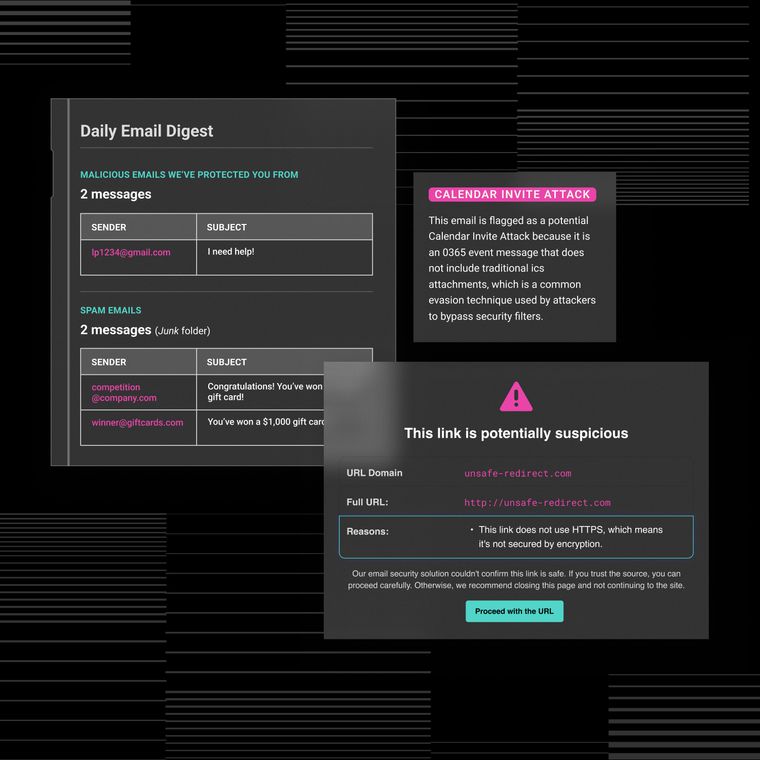Your Email Authentication Playbook: How to Implement It Right
Learn how to implement email authentication protocols like SPF, DKIM, and DMARC to protect your domain and boost deliverability.
July 10, 2025
Google and Yahoo's February 2024 requirements made email authentication mandatory with bulk senders. The requirements mandate the implementation of the Sender Policy Framework (SPF), DomainKeys Identified Mail (DKIM), and a minimum p=none Domain-based Message Authentication, Reporting, and Conformance (DMARC) policy, while maintaining spam rates below 0.3%.
As AI-generated phishing campaigns become increasingly sophisticated, CISOs need comprehensive authentication strategies that extend beyond basic compliance. This guide covers the implementation of email authentication using these core protocols and provides actionable steps to follow.
What Is Email Authentication?
Email authentication is a set of DNS-based checks or protocols, primarily SPF, DKIM, and DMARC. These protocols enable receiving mail servers to confirm that a message originates from your domain, verify it hasn’t been altered in transit, and determine how to handle any failures of these tests, thereby preventing domain spoofing and safeguarding both inbox placement and brand reputation.
SPF lists the IP addresses allowed to send on your behalf; precise SPF record syntax lets the recipient confirm the envelope sender. DKIM attaches a cryptographic signature to each message; recipients verify that signature using the public key you publish, ensuring both integrity and origin. DMARC ties everything together by instructing receivers on what to do when SPF or DKIM fails, thereby enforcing alignment with the visible From address.
Implementing all three protocols creates a layered authentication system that automated filters recognize as increasing the trustworthiness of messages.
The Importance of Email Authentication
Spoofed domains fuel Business Email Compromise (BEC), CEO fraud, vendor-invoice scams, and even the classic Nigerian Prince scheme, which still tricks users today. Attackers frequently impersonate well-known brands to bypass basic filters, costing enterprises millions of dollars annually.
With authentication enforced, attackers cannot simply use your logo on a phishing message and bypass filters. Major inbox providers already reward authenticated traffic; Google and Yahoo now block or label as junk bulk mail that lacks SPF, DKIM, or a minimum DMARC policy.
Together, these protocols close loopholes that cybercriminals exploit when only one control is present. An attacker can bypass SPF by hijacking a whitelisted IP address, yet still spoof the From header. DKIM alone can validate a message that claims to be from your domain but was signed with a stolen key. DMARC's alignment requirement eliminates those gaps and its reporting stream pinpoints abuse attempts in real time.
When you combine these records correctly, you give inbox providers an unambiguous signal that every message truly originates from you, and that forged copies should never reach your customers.
Let’s take a look at the step-by-step implementation of these protocols.
Step-by-Step Setup: SPF
SPF is the first and fastest way to cut spoofed mail that claims to come from your organization.
SPF works after the SMTP handshake. When your message reaches a receiving server, that server compares the connecting IP to the list you publish in DNS. If the IP is on the list, SPF passes; if not, the message is tagged or rejected. Because SPF only examines the envelope MAIL FROM domain, pairing it with DKIM and DMARC remains essential for full "From" address protection.
Step-by-Step Setup: DKIM
Deploying DKIM means you digitally sign every outbound message with a private key, allowing recipients to confirm its origin and integrity. DKIM adds a cryptographic signature to selected email headers. Your mail server hashes the headers and body, encrypts the hash with a private RSA key, and inserts the signature into the DKIM-Signature header.
The receiving server retrieves the matching public key from a DNS TXT record, decrypts the hash, recreates its hash of the received message, and compares the two. A match proves the email is authentic and has not been tampered with in transit.
Here’s what you need to do:
Generate a 2048-bit RSA key pair, which is now the industry baseline for resisting brute-force attacks. Most cloud email platforms automatically create the key. For self-hosted environments, use openssl genrsa -out private.key 2048 followed by openssl rsa -in private.key -pubout -out public.key. Publish only the public key and store the private key in a restricted directory with limited administrative access.
Next, choose a selector—a short, human-readable tag that lets you maintain multiple active keys. Create a DNS TXT record at selector._domainkey.yourdomain.com. A complete example:
selector1._domainkey 3600 IN TXT "v=DKIM1; k=rsa; p=MIGfMA0GCSq...IDAQAB"
Break the p= value into quoted segments under 255 characters if necessary; servers reassemble them automatically. Set a reasonable TTL (one hour is common) so updates propagate quickly.
Avoid Common DKIM Pitfalls
Several pitfalls derail otherwise sound deployments of DKIM. Mis-spelling the subdomain (_domainkey is required), publishing the wrong selector, or pasting a truncated p= string all lead to hard fails. Keys under 1024 bits are routinely flagged as weak, and records with stray semicolons or missing quotes won't parse.
You need to verify your record once it's live. Send a test message to a Gmail account, open the message, choose "Show original," and confirm dkim=pass. The command-line checks dig selector._domainkey.yourdomain.com TXT for DNS presence and openssl dgst -sha256 -verify public.key -signature sigfile msgfile for signature testing, offer deeper validation. Free web tools perform the same checks without local scripts.
Plan for key rotation every six to twelve months. Generate a new selector, publish its DNS record, enable signing with the new private key, and retire the old selector only after mail signed with it has aged out of recipient caches (typically a week). Remove unused selectors to shrink your attack surface and update any archival or backup systems that rely on old keys.
With DKIM reliably signing your traffic, you're prepared to enforce alignment in DMARC and unlock advanced protocols, such as Brand Indicators for Message Identification (BIMI).
Step-by-Step Setup: DMARC
DMARC aligns the visible 'From' domain with your SPF and DKIM results, giving you the power to decide what happens when that alignment fails, turning guesswork into policy-driven control.
Start by understanding alignment. An incoming message passes DMARC only if the domain in the From header matches (or is a subdomain of) a domain that already passed SPF or DKIM. This simple rule closes the loophole that allows attackers to spoof your brand, even when individual protocols are successful. This alignment requirement converts two separate checks into a unified framework.
Next, publish a basic record to observe traffic without disrupting it:
v=DMARC1; p=none; rua=mailto:dmarc@yourdomain.com; ruf=mailto:forensic@yourdomain.com; pct=100
Each tag serves a specific purpose: v=DMARC1 identifies the record type, p=none tells receivers to deliver mail even if it fails (monitoring mode), rua collects aggregate XML reports listing sender IPs, pass/fail counts, and alignment status, ruf requests forensic copies of individual failures for deep analysis, and pct=100 applies the policy to every message.
Go Beyond the Basics: BIMI, MTA-STS, TLS-RPT, and ARC
After you have secured SPF, DKIM, and DMARC, the next generation of standards—Brand Indicators for Message Identification (BIMI), SMTP MTA Strict Transport Security (MTA-STS), SMTP TLS Reporting (TLS-RPT), and Authenticated Received Chain (ARC), extend your defenses.
These add visible brand markers, enforce end-to-end encryption, deliver detailed failure reports, and preserve authentication through forwarding, thereby closing the security and trust gaps that the core protocols alone cannot address.
Display Trust with BIMI
Brand Indicators for Message Identification displays your logo as a security control. BIMI requires DMARC enforcement, a Verified Mark Certificate (VMC), and proper DNS configuration. Gmail, Yahoo, and Apple Mail display authenticated logos directly in the inbox, providing recipients with immediate visual confirmation of legitimacy.
Deploy BIMI after achieving DMARC quarantine or reject status. Obtain a VMC through an approved certificate authority, host your SVG logo on HTTPS, and publish the BIMI DNS record. The result: stronger brand-spoofing protection and higher open rates through visual trust signals.
Enforce Encryption with MTA-STS
Mail Transfer Agent–Strict Transport Security blocks downgrade attacks that force SMTP traffic onto unencrypted connections. You publish a DNS TXT record and serve a policy file over HTTPS specifying which MX hosts must use TLS.
When external servers deliver mail, they check your policy. If TLS negotiation fails under "enforce" mode, the sender defers or bounces the message, preventing interception. Deployment takes under an hour with existing DNS and web infrastructure. Google Workspace and Microsoft 365 support MTA-STS for outbound mail, but do not currently enforce MTA-STS policies for inbound mail.
Gain Visibility with TLS-RPT
SMTP TLS Reporting provides data on encryption failures. A DNS TXT record specifies email addresses for daily JSON reports containing handshake errors, certificate mismatches, and cipher failures.
These reports expose misconfigured partners and targeted attempts to downgrade. Integrate TLS-RPT data with SIEM tools to create actionable dashboards and facilitate trend analysis. The visibility enables rapid remediation before mail delivery suffers.
Protect Forwarded Mail with ARC
Authenticated Received Chain preserves authentication results through intermediaries like listservs and ticketing systems. Each forwarding hop adds an ARC-Seal header that vouches for the previous authentication status and cryptographically signs the chain.
The receiving MTA trusts the original DKIM signature and SPF evaluation despite forwarding modifications. Enable ARC signing on your gateway or cloud platform and publish the public key in DNS. This reduces false positives for legitimate forwarded mail while maintaining detection accuracy.
Choosing the Right Mix
Start by matching each protocol to your most significant risks and the resources you have on hand. If brand impersonation is eroding customer trust and you already enforce DMARC, consider adding BIMI so your authentic logo appears in inboxes and impostors stand out.
If you work in a regulated field and handle sensitive data, lean on MTA-STS and TLS-RPT to keep mail encrypted in transit and to get clear reports when something goes wrong. Teams that rely heavily on email forwarding will see the most significant payoff from ARC, which maintains authentication integrity as messages are transferred between servers. Layer these tools on top of SPF, DKIM, and DMARC to build a resilient, multi-layered defense against both technical attacks and social engineering tricks.
Best Practices to Maintain Strong Authentication
Strong email authentication demands ongoing maintenance such as quarterly audits, real-time monitoring, and disciplined change control to keep your SPF, DKIM, and DMARC defenses intact.
Here are the best practices to follow:
Run a Quarterly DNS audit: Every 90 days, review every TXT record tied to your primary domain and each subdomain. Start by exporting the current records, then compare them against the list of authorized senders. Pay special attention to the ten-lookup ceiling in SPF records; exceeding it will break validation and silently erode protection. Your audit should confirm that the SPF record lists all active mail hosts and excludes retired services, each DKIM selector publishes a valid 2048-bit key, and the DMARC policy aligns with your enforcement plan. This prevents drift and ensures new marketing tools or ticketing platforms do not bypass policy.
Monitor Authentication Telemetry: Publishing records is not enough; you must watch the signals they generate. Enable DMARC aggregate reports (rua) and forensic reports (ruf), then feed them into a dashboard that highlights failures by source and volume. Continuous insight lets you correct misaligned senders before Gmail or Yahoo throttle delivery. Pair DMARC visibility with TLS-RPT reports to surface encryption errors that could expose messages in transit. When the data shows a spike in failures, identify the offending IP range, update SPF or rotate the DKIM key, and rerun validation.
Rotate and Retire Cryptographic Keys: Treat DKIM keys like privileged credentials. Generate 2048-bit pairs and rotate them every six to twelve months. During rotation, publish the new selector in DNS, enable signing, then phase out the old selector only after you see passes in live traffic. If a private key is ever suspected of compromise, revoke it on the same day and push an emergency rotation. This discipline limits an attacker's window to misuse a stolen key and keeps you ahead of cryptographic advances.
Control Change and Third-Party Risk: Authentication often breaks when someone adds a new vendor without updating DNS, especially in email systems. Establish a change-management process that requires a security review before any SaaS platform is allowed to send as your domain. Keep marketing, IT, and security teams aligned with a single inventory of approved senders, and verify each one supports SPF and DKIM alignment. Assign ownership for every domain so you always know who is accountable for fixes.
Automate and Stay Current: Manual checks do not scale. Deploy automation that polls DNS for unexpected changes, parses DMARC XML into charts, and flags SPF lookup overages in real time. Track provider announcements—Google, Yahoo, and Microsoft revise authentication requirements frequently. Subscribing to their postmaster updates ensures you adapt policies before new rules impact deliverability.
By enforcing this cycle of auditing, monitoring, key hygiene, and governance, you guarantee that your initial authentication project matures into a resilient control that keeps attackers out and legitimate email flowing.
Integrating Authentication with Abnormal’s AI-Driven Security Platform
Authentication protocols such as SPF, DKIM, and DMARC stop most spoofed-domain attacks, yet they still miss sophisticated business email compromise (BEC) attacks launched from legitimate or look-alike accounts. AI-driven, behavior-based security platforms close this gap.
Here’s how:
Header validation alone isn’t enough. SPF checks the envelope and DKIM signs the body, but neither validates the visible From header. Attackers who hijack vendor mailboxes or register near-lookalike domains can pass these checks while slipping in malicious links or urgent payment requests. Behavioral context is essential to catch these tactics.
Seamless, cloud-native deployment. Modern AI email-security platforms integrate through APIs, eliminating the need for MX record changes or inline gateways. They analyze historical traffic to understand how each employee, team, and vendor typically communicates.
Real-time behavioral scoring. Every new message is evaluated in milliseconds for tone, intent, urgency, and conversational context. A polite but urgent wire-transfer request that falls outside the typical workflow triggers an immediate alert even when SPF, DKIM, and DMARC all pass.
Supply-chain awareness. The behavioral layer continuously profiles supply chain partners. If a contractor who usually invoices on the first weekday of each month sends a mid-cycle invoice with new bank details, the platform flags it as high risk. Thousands of signals such as sending history, device fingerprints, and relationship strength identify anomalies that traditional secure email gateways miss.Layered protection, not replacement. AI complements existing authentication. Your SPF, DKIM, and DMARC records remain in place, while AI inspects human intent, providing a multilayer defense.
Platforms like Abnormal apply behavioral AI to every inbound and outbound email, mapping long-term behavioral patterns of accounts to spot deviations that signal compromised vendors or internal users, catching the social-engineering tactics that protocols alone cannot. Request a demo to learn more about email security solutions.
Related Posts
Get the Latest Email Security Insights
Subscribe to our newsletter to receive updates on the latest attacks and new trends in the email threat landscape.


